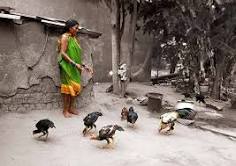Backyard Poultry Farming in India : Source of Livelihood for Rural Farmers & A way to empower India’s rural people
The importance of native breeds of poultry birds for rural economy in India is very high. They are part of balanced farming system that have vital roles in the rural households as a source of high-quality animal protein and emergency cash income and play a significant role in the sociocultural life of the rural community and woman empowerment. One of the most important positive characters of native chicken is their hardiness, which is ability to tolerate the harsh environmental condition and poor husbandry practices without much loss in production. The native breed chickens are the reservoir of genomes and major genes for improvement of high yielding exotic germplasm for tropical adaptability and disease resistance.
Indigenous or native breeds of poultry are playing an important role in rural economies in most of the developing and underdeveloped countries. They play a major role for the rural poor and marginalised section of the people with respect to their subsidiary income and also provide them with nutritious chicken egg and meat for their own consumption. According to the Indian government’s National Action Plan for Egg & Poultry-2022 (NAPEP), backyard poultry accounts for 20 percent of India’s poultry sector, which is worth over ₹800 billion (around £8.5 billion). Across the country, around 30 million farmers are engaged in backyard poultry, estimates the 19th Livestock Census of India. While India’s per-capita chicken meat consumption is around 3kg per year, compared to the world average of 17kg, the consumption of poultry meat has been very low in rural pockets. The main reason is the low purchasing power of people living in these areas. One of the primary objectives of popularising backyard poultry farming in rural India is to provide better income opportunities to the poor farmers and people from indigenous communities living in remote areas. Among its benefits is that it can help make rural women economically and socially empowered and can address the issues of food insecurity and malnutrition. Going by standard nutritional requirements, half an egg a day is optimal for an average healthy person, which translates into 180 eggs per person per year. But the present availability is around 79 only. Backyard poultry farming primarily involves country chicken birds. In India some of the important breeds/varieties which have been documented are Aseel, Ankaleshwar, Busra Chitagong, Daothigir, Denki, Ghagus, Haringhatta black, Kadaknath, Kalasthi, Kashmir Faverolla, Miri, Punjab Brown, Tellichery, Titri, Teni, Nicobari, Naked neck, and frizzle fowl. Besides this many nondescript desi poultry breeds are reported. Raising of local poultry birds in backyard is an important source of livelihood for the rural people. In this regards popularisation of backyard poultry is essential in India to ensure increasing access to protein and nutritious food at an affordable price in rural India.
Although poultry farming has shown a very promising and rising trend in recent days, the major growth of this industry was found confined in urban or semi-urban areas of the country. It is easily understandable that most of the rural population don’t have opportunities to access fresh eggs and chicken meat from intensive farming or commercial poultry sectors due to a lack of proper preservation facilities and very little demand for processed meat (Devi et al., 2014). It’s a fact that 65% of the Indian population is estimated as rural people (Kumar et al., 2020) and their staple food is carbohydrates like rice and wheat. They don’t get a substantial amount of protein from their daily food. Therefore, it is extremely important to protect them from malnutrition and associated diseases by providing them with balanced nutrition with animal protein supplements. To overcome this issue, along with the intensive poultry production system, backyard poultry farming (BYPF) using highquality chicken breeds or native breeds is not only drawing huge attention but also acquiring popularity in the rural population to resolve the problems of hunger, malnutrition and protein deficiency (Alders et al., 2018). Moreover, BYPF would be a potential subsidiary income source among the rural people in our country (Kumar et al., 2021). Backyard poultry farming could be an excellent initiative for rural people of India and may play an important role in improving food security and sustainable development. In this current scenario, small-scale poultry farmers are facing hurdles at the initial stage of their business establishments but strategic management and support from NGOs, social volunteers, Govt. sectors are expected to increase the net productivity and costeffectiveness of backyard poultry farming (Fig. 2). Scientists already identified the major hurdles in this field including, unavailability of superior breeds, poor health and hygiene, recurrent emergence of viral diseases in poultry birds, antibiotic resistance-related problems, inappropriate infrastructure for rearing house and night shelters, the high price of chicken feed supplements, a high mortality rate of the birds, etc. With the advancement of animal husbandry research, effective and low price vaccines, quality supplemental feeds, disinfectants, and improved poultry water sanitization systems are available now in the market. Therefore, it is anticipated that challenges and limitations will reduce to a substantial level soon. Also, the practice of backyard poultry farming will give the benefit of economic independence to the rural women who are actively involved in this small business. Farmers need to comprehend the importance of native and better-quality breeds for the improved production of eggs and meat as they have a good demand nowadays. Overall, the cooperative backyard poultry farming model will be beneficial and environment-friendly if proper strategic planning and training are provided to the poultry farmers on regular basis.
Phases of backyard poultry farming
There are two important phases of backyard poultry farming including, a) nursery rearing and b) free-range rearing.
a) Nursery rearing: The most important point in nursery rearing is artificially providing proper feed, temperature, protection to the newborn chicks (Hedlund et al., 2019). This phase is extremely important in backyard farming as it resembles intensive poultry farming in the context of quality feeding, proper management, and good health care practices (Rajkumar et al., 2021). In this phase, chicks are reared until they reach the age of 4-6 weeks and mature enough to start scavenging their feed and protect themselves from their surrounding predators.
b) Free-range rearing: Another important phase in which chicks ( between 4-6 weeks of age) are familiarized into the backyards carefully. Poultry farmers should observe the seasonal temperature before introducing the chicks in the backyard. The total number of domestic chicks mainly depends on the availability of area coverage and the source of natural feed. According to experts, a total of 15-20 chicks per family is an ideal number for effective free-range rearing. It was observed that up to 200 chicks are ideal for rearing under a small-scale freerange phase. In that case, chicks are needed a large foraging area and a hygienic poultry house for their night shelter (Tufarelli et al., 2018). To get optimum productivity from chicken, ‘supplementary feeding’ is of utmost importance. In general, chickens reach their protein requirements during foraging in backyards. They scavenge on insects, soil worms, etc. After foraging in the daytime, the chickens should be fed with cereal grains and oilseed cakes in the evening. Through this process, chickens are meet the basic requirements of essential nutrients (Tufarelli et al., 2018). Farmers should give the mixture of stone grit, shell grit, or lime powder as a calcium supplement during the egg-laying phase (Wakenell et al., 2016). It was proven that without proper calcium supplements, chickens often lay brittle or broken eggs, even shell-less eggs (An et al., 2016).
The usefulness of small-scale intensive poultry farming in the rural area
Small-scale intensive poultry farming is mostly practiced by rural, resource-poor people who often experience food insecurity throughout the year. Such a poultry farming model is easily accessible to those rural people, and most importantly it could be a good income and nutritious food source for them to improve food security (Kumaresan et al., 2008). Not only does small-scale poultry farming enhance nutrient utilization in a better way, but also it greatly contributes to mixed farming practices and women empowerment in rural India (Nordhagen et al., 2018). Generally, poultry farmers should start small-scale intensive farming including 200 to a few thousand chickens, which could be reared in a similar way to intensive broiler farming. Intensive farming should be continued till chickens reach a bodyweight of about 1.5 kg in a flock. Such practice is beneficial for the production of meat by using fast-growing chicken varieties including, Krishibro, Vanaraja, Kuroiler, Srinidhi and Rainbow Rooster (Rajkumar et al. 2021). It was estimated that about 10–20% of the backyard poultry farming is continued with this model system, especially in north-eastern states, and large areas in Himachal Pradesh (Thakur et al., 2012). Apart from the beneficial side of extensive small-scale poultry production systems, rural farmers often face significant obstacles to getting full benefits due to disease and predation. Such problems can be overcome with better agricultural and livestock management (Conan et al, 2012).
The management of small-scale intensive poultry farming
Studies demonstrated that native village chickens are useful and an important income source for domestic expenses. Traditional freerange poultry production systems in developing countries can be improved with the proper use of quality dual-purpose chickens (Kumaresan et al., 2008). Important Indian chicken breeds which were documented for small scale intensive poultry farming including, Ankleshwar, Aseel, Daothigir, Busra Chittagong, Denki, Haringhatta black, Ghagus, Kadaknath, Kashmir Faverolla, Kalasthi, Miri, Tellichery, Punjab Brown, Titri, Nicobari, Teni, frizzle fowl and Naked neck (Agarwal et al., 2020). Apart from the documented breeds, some desi chicken breeds are also reported (Sankhyan et al., 2013). According to research, scientists have found eight different strains of native chickens which are identified and reared by the rural peoples of East Godavari district of Andhra Pradesh including, Shankarjati Kodi, Nati Kodi, Medajari Kodi, Geesa Kodi, Rencha Kodi, Mattedu Kodi, etc. Interestingly, these indigenous breeds are Aseel in origin which has great value for their tasty meat, good fighting abilities, agility, and quick escape ability from their predators (Padhi et al., 2016). But farmers need to keep in mind that native chickens are slow growers in nature. Naturally, desi hens lay about 50-100 eggs in a year with alternating brooding phases. As discussed earlier, Aseel meat is superior in quality and composition; therefore, it is very popular among native chickens compared to commercial broilers (Rajkumar et al., 2016). It was observed that the native chickens are slow-growers and also poor layers in nature but they have the qualities to be ideal as a brooder, exceptional foragers, robust-bodied, and resistant to seasonal diseases (Rajkumar et al., 2017). Maintaining good chicken varieties which are highly productive, have better immunity against seasonal diseases with a short budget for nutrition and management is challenging for the farmer. Therefore, farmers always need to maintain good breeds or varieties. The researcher suggested good ways to introduces elective breeding in already established desi breeds and also crossbreeding with exotic varieties or native breeds (Rajkumar et al., 2021). Besides breeding, nutrition plays a crucial role in regulating the genetic potential of the poultry chickens for improving the numbers and quality of eggs, also maintaining their body weight. Well-adjusted nutrition should provide young chicks with their overall health improvements and proper functioning of body metabolism (Cherian et al., 2015). Of note, the requirements of nutrients vary with the type of breed, body size, genetic makeup, age, the temperature inside the poultry, physical stressors, etc. (Barzegar et al., 2020). The importance of night shelter in backyard poultry was always mentioned by different experts (Conan et al., 2012). Therefore, night shelter infrastructure should be proper for the birds to protect them from predators and adverse outside environmental conditions. The types of night shelters are variable and largely depend on the flocks’ size as well as available resources (Al-Qamashoui et al., 2014). In India, smallscale and intensive poultry farmers usually made night shelter constructions with asbestos roofs, concrete walls (made up of cement instead of mud), and wire mesh for cross-ventilation purposes (Zhao et al., 2014). It was estimated that a poultry bird ideally requires one square feet space for their growing phase and around 2.5 square feet during the egg-laying phase inside the night shelter (Kumar et al., 2013). Another important aspect of the backyard poultry management system is always to keep an eye on the health issues of birds. The studies showed that health management in poultry largely depends on bio-security and proper vaccination (Hofacre et al., 2002). Maintaining the highest level of bio-security like the commercial sector could be difficult for backyard poultry farmers such as proper immunization of birds under the scavenging system, veterinary facilities, protection from predator attacks were considered main constraints for the small-scale poultry farmers (Hossain et al., 2021). The most predominant chicken diseases were found as Newcastle disease and Fowlpox. These viral diseases show remarkable infectivity in the hot and humid coastal regions, therefore periodic vaccination is extremely important to protect the flocks (Hassan et al., 2020). Also, the chickens are naturally exposed to different pathogenic loads while scavenging and need continuous monitoring of their health conditions. If some disease symptoms appear, immediately the diseased birds should be separated from others and need to take necessary measures (Galarneau et al., 2020). Despite the several limitations, it is recommended to practice mass vaccination programs with the help of local NGO teams, veterinary experts, Govt. departments to control the viral diseases effectively (Kumar et al., 2015). It was a proven fact that the proper use of a thermostable vaccine has successfully decreased the Newcastle disease infection in backyard poultry farming (Dey et al., 2017). Apart from this, there are possibilities for poultry birds for exposing different other pathogens including, avian influenza, infectious bronchitis, infectious bursal disease and Marek’s disease which are potential causes of significant morbidity and mortality (Fulton et al., 2013). Some bacterial and parasitic diseases also cause harm to the poultry birds but can be prevented with proper vaccination and biosecurity measurements (Hauck et al., 2017). According to research, both bacterial and parasitic infections occur from the source of contaminated poultry feed and water. To prevent such situations, mass deworming should be done in specific time intervals (six months intervals recommended) (Bessell et al., 2019). It is generally suggested to apply deworming-related medications a week before the vaccination of poultry birds to prevent viral diseases. Several studies identified the potential source of contamination as sewerage in the backyards. The contaminated water mostly contains different harmful intestinal parasites including cestodes, nematodes and trematodes, which affect the health and hygiene of poultry birds (Asumang et al., 2019) and could be a reason for huge losses to the poor farmers. Other sources of external parasites are night shelter houses or poultry rooms with unhygienic conditions such as the damp, moist, wet floor, and poor ventilation systems (Singh et al., 2017). Therefore, experts always suggest to poultry farmers to keep breeding and rearing areas clean with proper disinfectants (Fig. 1). Small-scale intensive poultry farming needs proper surveillance, training, reporting as well as the documentation of breeding history, abnormal symptoms of birds, vaccination, mortality trends if concerned, etc. (Thornton et al., 2010) Antibiotic resistance in poultry birds is a matter of concern now. Data suggested that substantial anti-microbial resistance of E. coli bacteria in chicken was developed in most of the poultry farms worldwide. Interestingly, Norway and Sweden had good practices for using fewer antibiotics showed lower levels of E. coli resistant in poultry birds (Wierup et al., 2021). According to research, overuse of antibiotics may have some adverse effects on chicken such as administration of tetracyclines for a long time may show metabolic deregulations and immunosuppressive effects. For these reasons, there was a reduction of normal intestinal microbiota observed in the gut of poultry birds and they become more prone to different opportunistic infections (Shang et al., 2018). During excessive antibiotic treatment, commensal microbes are destroyed in young birds and there is a fair chance to develop harmful bacteria and coccidia populations (Noack et al., 2019). Prolonged use of other two antibiotics including, aminoglycosides and sulfonamides may damage the kidney and weaken the minerals absorption capacity in poultry birds (Mund et al., 2017). Also, the overdose of steroid hormone therapy demonstrated a negative effect on chicken’s health and sometimes causes food toxicity (Jeong et al., 2010).
Importance of microfinancing co-operative poultry farming model in rural India
The micro-financing cooperative poultry farming model was considered beneficial for small-scale intensive farmers who own the local poultry farms and together run and share the profits (Kumar et al., 2015; Chaiban et al., 2021). The successful cooperative poultry model was established by a nonprofit organization in the central part of India with nearly 10,000 farmers. Importantly, most of them were rural women, previously involved in other manual laborworks. After successful training on poultry management, women farmers were provided with initial monetary support by giving a part loan to build the poultry farming infrastructures. In this model system, each farmer is required to start work with 300-400 chicks. Currently, they work with 600- 1000 chickens/batch, and the estimated productivity level is 220 eggs/chicken/year. Moreover, the health and hygiene issues of each poultry farm (known as a cluster) are monitored by the team of para-veterinary personals (Beesabathuni et al., 2018). Nowadays, several microfinance organizations are supporting smallscale intensive poultry farmers in rural areas. The cooperative model was successful in India because of the flourishing and fast-growing input industries, giving procurement at affordable prices for different NGOs to help poor farmers. Studies also suggested that India achieved the position of the third-largest producer of eggs in the world, mostly with the collective efforts of medium and large-scale poultry farms (Chatterjee et al., 2015).
Challenges in rural poultry farming in tribal areas
The native chicken varieties adopted in the free range backyard conditions in tribal areas have low productivity and their contribution to the total egg output is almost static for the last few decades. Therefore, the consumption of eggs in the tribal areas is far below the national average across the country. Increasing the genetic potential of the local chicken varieties greatly helps in increasing the availability of poultry products in tribal areas. The chicken varieties being used in the intensive poultry farming cannot survive in free-range, where the disease challenge is high, climatic variations are harsh and adverse and vary greatly from place to place and season to season. Adapting the intensive poultry farming in small scale in tribal areas may not be economically viable due to limitations in management, high input cost and non-availability of inputs in rural/ tribal areas. However, due to non-availability of poultry products, the prices are up to double in tribal areas compared to those prevailing in the other part of the country. Therefore, it is necessary to popularize suitable chicken varieties, which can thrive in backyard free-range conditions without expensive inputs like commercial feed, supplement and medicine etc. Predator menace, harsh and diversified climatic conditions, diseases, consumer preferences, lack of commercial feed etc. are some of the major issues, which need attention while popularizing birds suitable for free range backyard farming. Adapting rural poultry farming in backyards of household can ensure the the availability of eggs and meat in rural and under developed areas; which will heil in alleviating the incidence of protein deficiency particularly in tribal areas.
Management
Backyard germplasm can scavenge well for its feed in the fields (Table 2). During the process of scavenging on grass fields these birds will have an access to insects, white ants, green grass, grass seeds, waste grains etc, thereby the supplemental feed requirement is lesser than those reared under intensive poultry farming. Feed supplementation in the form of scratch usually given in the morning/evening to develop habit to reach owner’s place for laying eggs and for night shelter. Depending on the availability of free range area and also the intensity of vegetative growth, the requirement of supplemental feed varies between 25 and 50 g/bird/day. These birds can also perform well on whole grain feeding under scavenging conditions.
Housing management for backyard poultry farming
Simple housing is required for backyard poultry farming but, it should be needed for the comfort, protection from sun, rain, predators and efficient production of eggs and meat. Thus proper housing is one of the prerequisites of sound poultry farming and a good housing is comfortable, safe, economical and convenient. If free range system is practiced the birds are let loose in day time for foraging and at night sheltered in shed. Generally 5-10 birds are raised in backyard system for home consumption, 10- 30 birds for income generation and home consumption but more than 50 birds for primarily income generation purposes (Sonaiya, 1990a). For better production performances certain criteria are as follows: The poultry house should be in east-west orientation to protect from summer wind and cold stress and also for direct sunlight in winter months. During summer direct sun light should be avoided to reduce the summer stress in birds. Low cost housing material like wood, bamboo, grass, thatch etc can be utilized. The poultry house should be free from water seepage or moisture. Floor should be in elevated land or above ground level (minimum 2ft) and free from water crack, easily cleaned, rat proof and durable. There should be free air movement in upper part of the shed to reduce gas formation inside the shed. Height of the side wall in poultry house is generally 7 ft to 8 ft. The centre height is 9 ft to 12 ft with slope in either side. Roofing material like thatch, tiles, asbestos etc can be used. Brooder house should have easy ventilation and wire netting which is used for open air ventilation. Provision of bulb fitted above the ground as hover may be utilized to keep the chicks warm.
Brooding of chicks
Brooding means to care day old chick upto growing period. In backyard poultry farming, there are two types of brooding of chicks followed viz. natural brooding and artificial brooding.
Natural brooding
Indigenous breeds of chicken are having good broodiness properties and hens are very good sitters. A broody hen can sit on 12-15 fertile eggs for incubation. The hen is provided nest with bedding or litter materials. A broody hen can easily take care for brooding of 10 to 12newly hatched chicks. After hatching the chicks are let loose along with mother for scavenging. During night mother along with young chicks should be kept separately from other birds inside the shed.
Artificial brooding
In artificial brooding of chicks, artificial heat is necessary. Artificial heat can be provided by different heat sources like electricity, gas, kerosene, wood, sawdust etc. Wood, charcoal or sawdust is used as fuel in Bhukari and it is an ideal source of artificial heat when there is shortage of electricity, gas and kerosene. The chicks should be protected from direct contact with artificial heat source, a chick guard made up of card board or metallic guard can be used in brooder house. The height of chick guard is 15 to 18 inches and is placed in circular shape at a distance of 3 feet away from the hover. The optimum temperature is 95⁰ F in first week and it can be reduced by 5⁰ F per week up to 6 week till 70⁰ F. Light in brooder house is necessary to increase feed consumption for maximum growth in a short period and also to prevent stampeding or piling. There should be provision of continuous light of24 hours in brooder house up to 6 weeks. Light is required 15-16 hours which induces sexual maturity and egg production during laying period (Leeson et al., 2005).
Feeding management
In backyard poultry farming the feed cost input is considered to be minimum or nil. In this poultry farming system, the birds are let loose for scavenging in the open areas during day time. They feed on insects, termites, seeds of grasses and weeds, leftover grains, crop residues and household wastes for their protein, energy, minerals and vitamins requirement. Feed for birds can be prepared by ingredients like broken rice, rice bran, wheat bran, wheat, bajra and grains as well wastage of pulses etc. In backyard poultry farming generally feeding is practiced two times in a day (morning and evening) if birds are in confined area. An adult bird can require feed 105 to 120 gram/day. The bird may be supplied with extra feed ration @ 30 to 40 gm/ bird/ day for better performance when they are reared on scavenging (Sonaiya, 2004). The balanced ration may be formulated with appropriate percentage of maize, bajra, rice bran, rice polish, wheat bran, oil cake, fish meal, shell grit or lime stone along with salt, minerals and vitamins. Local available ingredients should be considered first during feed formulation which may reduce the feed cost. The poultry feed should contain at least 17- 20% protein with energy level (ME) more than 2600 kcal/kg feed.
In backyard poultry farming, the feed cost is considered to be minimum. The birds consume the required protein, energy, minerals and vitamins etc., from the snails, termites, leftover grains, crop residues and household wastes. Feed ingredients like broken groundnut straw and wheat grains can also be given to the chicks. The chicks may be supplied with extra concentrate ration@30-60 gm/day/chick for better performance. The chicks need balanced feed during the initial 6 weeks of age under brooder by providing balanced chick feed during the early period of growth. The average body weight of 1.5 to 2.0 kg will be attained upto 5 (4-6) weeks and if required should be provided with supplemental calcium sources like lime stone powder, dicalcium phosphate (DCP), stone grit, shell grit at 4 to 5 grams/bird/day.
Ingredients for balanced ration
| Ingredient | 0-8 week old
birds |
9-20 week old
birds |
More than 20 week
old birds |
| Maize | 52 | 45 | 46 |
| Soybean | 18 | – | 15 |
| Groundnut oil | 13 | 13 | 8 |
| Rice polish | – | 35 | – |
| Deoiled rice polish | 15 | – | 22 |
| Fish meal | – | 06 | – |
| Limestone | – | – | 7 |
| Dicalcium phosphate | 2 | 01 | 02 |
| Salt (g) | 200 | – | 300 |
| Vitamins (A,B,D,K) g | 15 | 15 | 15 |
| B complex | 20 | 20 | 20 |
| Vitamin B12 | 15 | – | – |
| Trace minerals (g) | 50 | 50 | 50 |
| Coccidiostat | + | – | – |
weather conditions, windows, doors and fans need to be effectively used to maintain optimum ventilation.
Beak trimming: Trimming of beak is an important manage mental practice and should be done by trained people. This is done to prevent cannibalism and wastage of feed. Beak trimming is a sensitive operation. It is done at 3rd week and one third of upper beak should be trimmed.
Floor space: The chick should be provided sufficient feed and floor space. Overcrowding results in stress and mortality. Chick requires 8 square inches of feeding space. During the 6th week, 1 sq. ft. floor space per chick must be provided to avoid overcrowding.
Space requirement for poultry
| Age
(Weeks) |
Floor space
(sq. ft) |
Feeding space
(cm) |
Watering space
(cm) |
| 0-4 | 0.5 | 2.5 | 1.5 |
| 4-8 | 1.0 | 5.0 | 2.0 |
| 8-12 | 2.0 | 6.5 | 2.5 |
Ventilation: Supply of fresh air to the chicks is highly essential. Brooding will cause depletion of oxygen and results in building up of carbon dioxide, ammonia etc. The airtight curtains should be avoided. It is recommended to keep a gap of 3.5 inches between the ceiling and side curtains to facilitate gas exchange between the house and environment. In extreme
Health care management
For better health care in backyard poultry farming birds should be vaccinated against viral diseases. The diseases that mostly affect the birds are Ranikhet disease, Marek’s Disease, Gumbro disease etc. Vaccination schedule should be followed in backyard poultry production system where the disease prevalence to protect birds from the diseases at farm and it should be done timely and regularly. Vaccination schedule for poultry birds is given in Table 3. Deworming of birds for parasites should be done at 3-4 months interval to maintain a healthy and worm free flock. Other bacterial, protozoal and mycoplasma diseases that affect the poultry birds are CRD, Coccidiosis, infectious coryza and Salmonellosis etc. At proper time interval there should be provision of spray disinfectants for bio-security and to protect the flock in backyard system from diseases. Vaccination against Ranikhet Disease should be repeated at an interval of every 60-90 days during laying period (Ratanasethakul, 1988).
Importance of local breeds in backyard poultry farming system
Small scale holder backyard poultry production utilizing local breeds is expected to come under serious competition with the commercial poultry sector and if not well planned the genetic resources of local poultry may be lost. Conservation of local poultry breeds along with improvement for traits like meat and eggs will increase competitiveness to survive in the market. The socio-religious use of local poultry breeds, superior adaptability in their habitat, ability to perform in low input production system and the production system which is similar to organic production will give competitive advantages of backyard system over commercial poultry production. Backyard poultry farming gives very high return as the investment is very low. The local breeds of poultry/indigenous poultry genetic resources are held in high esteem even after 50 years of industrial poultry production because of the following reasons:-
- Local poultry breeds exhibit superior adaptability in their habitat and possess the ability to survive, produce and reproduce on low level of nutrition and sub-optimal management.
- The inputs required are very small, as they scavenge their feed requirements and are raised with little veterinary care.
- They possess the ability to protect themselves from predators.
- All the local breeds show broodiness and hatch their own chicks.
- People prefer eggs and meat of indigenous as poultry compared to those realized from farm-breed chickens consequently eggs and meat from local breeds are sold at a premium price.
- Cock fighting is a popular sport for the ethnic tribes and the local breeds are superior to exotic breeds in fighting.
- Use of coloured bird for socio-religious.
Free-range Poultry Farming
Free range system is best adapted to small- scale farmers who raise chicken for sale. Free-range extensive poultry farming (Fig. 1.2) is commonly practiced in Africa and Latin America. This low-cost free range system increases the commercial value of poultry. Under free-range conditions, the birds are not confined and can scavenge for food over a wide area. They are often kept in movable houses surrounded by fence. Their position is changed on a regular basis, so that the birds have access to a more or less constant supply of fresh green vegetation, with some insects, worms and other natural food. This is similar to systems in North America called Range Poultry or Pasture Poultry. Here, rudimentary shelters may be provided which may or may not be used by birds. The birds may perch outside, usually in trees and nest in the bush. As such, there is no practice of feeding not even handful of grains. The flock contains birds of different species and varying ages. The growth rate and egg production is very less. Usually, non-descript fowls are reared in this system. Extensive range poultry production requires more land and is usually part of a diversified operation with cattle, sheep, goat, pig, rabbit etc. Soil fertility is a major motivation and producers are able to take advantage of the poultry manure to improve their pastures for ruminants.
Points kept in mind for backyard poultry farming
- Trainings: Poultry farmers must approach to Krishi Vigyan Kendra’s to obtain the basic training on backyard poultry farming. This is very useful for rearing of chicks, feeding, housing and disease
- Exhibitions: Through regular exhibition of local poultry breeds in Kisan Melas, Animal Camps, Livestock Championship and other poultry exhibitions, helps in the selection of good quality
- Breeding of local poultry breeds: Since most of the small holder poultry farmers are poor, Government should extend assistance to improve the poultry farming system by providing good quality chicks to the backyard poultry and suggest for multiplication of birds at their own level from these good quality hens. Within a time frame the skills are to be transferred to farmers at village level. Attempt, however, should be made to retain broodiness in the local stocks since it makes the system auto generating. These hens can be used for producing the chicks at home
- Record keeping: In order to improve egg production, there is a need to record the performance of individual hens for egg production. It is not a problem to obtain this information since each hen lays her egg in a separate nest regularly. This will provide information on laying capacity and hatching performance for each hen. Those hens with higher egg production and hatchability should be selected to reproduce next generation.
Utilization of poultry manure as in vermicompost preparation
Vermicompost is a bio-fertilizer produced by earthworm feeding on organic waste material of animals, poultry and plant residues. Poultry manure is good source of organic materials which are required by earthworm for making vermicompost. Poultry manure is having about 30 percent protein. This bio-compost or vermicompost is an odorless, clean, organic material containing adequate quantities of N, P, K and several micronutrients essential for plant growth. It enriches soil fertility and improving its physicochemical and biological properties (Audu et al., 2015). It is a recycled biological product. It is a major component of organic farming system. The level of nutrients in compost depends upon the source of the raw material and the species of earthworm. A fine worm cast is rich in N P K besides other nutrients. Nutrients in vermicompost are in readily available form and are released within a month of application.
Vermicomposting for rural development
Large quantity of potential agro-industrial wastes and byproducts are thrown out as wastes/under-utilized by the local population since they are not aware of its importance. The materials can be utilized profitably by vermicomposting, which is a low cost technology. Unemployed rural population can do this, as part time/ full time profession if they are aware of the technical knowhow to utilize the materials. Awareness about Vermiculture and vermicomposting will motivate the rural people to start Vermicompost units, which can fetch regular income.
Revenue generation through vermiculture and vermicomposting
Vermi-technology is popular because it is a simple methodology with low investment and does not need sophisticated infrastructure. To process 10-15 kg of organic matter daily, it would require about 1.5 sq. meter of space with family member. Innovative, interested and talented rural people can be successful entrepreneurs in vermicompost production and to get job opportunities with the help of self-employment schemes. Backyard poultry production system is the most popular poultry farming practice in weaker section of society in rural areas. It plays an important role as secondary source of income. Knowingly or unknowingly, these people preserve the germplasm of the native breeds in their natural habitat. Upgradation of the native breed of chickens helps to increase the productivity of the bird and also their conservation in their natural habitat. There is no special requirement for backyard poultry farming. In the villages, backyard poultry production system is generally based on traditional native breeds which produce both egg and meat. By rearing of improved breeds of chicken, it can increase egg and meat production creates more income. It provides quality nutrition as poultry meat and egg which reduce the malnutrition among rural population of country. The overall aims of development of backyard poultry system are to reduce poverty, malnutrition and increase income of rural poor families. It helps in conserving the natural resources and maintaining biodiversity. It also helps to promote respect in society.
Both backyard and free range systems are extensive system of rearing the poultry with many similarities between them which are as follows:
- These are as such not an occupation but a supplementary household activity to farmers.
- In both the conditions, the high yielding exotic varieties fail to give better results. So, the non-descript or crossbred fowls are used.
- Both systems of rearing are usually found in rural areas unlike commercial poultry which is more in peri-urban and urban areas.
Varieties Developed For Backyard Poultry Farming in India
In rural areas of India, chicken reared are mostly desi type with low egg and meat production and there is need of introduction of improved dual purpose bird having capacity to lay more eggs and gain higher body weight than the local or desi birds. Realizing the importance of backyard rural poultry farming (RPF) in India, several research organizations developed different backyard chicken varieties.
- Varieties developed by CARI
Five important varieties of backyard poultry are developed by Central Avian Research Institute (CARI) which are detailed below:
- CARl Debendra
This is a medium-sized dual-purpose bird suitable for backyard rural poultry production system (Fig. 1). It was developed by crossing coloured synthetic broiler line as male line and Rhode Island Red (RIR) as female line at Central Avian Research Institute (CARI), Izatnagar – 243 122 (UP). The bird achieves moderate body weight of 1200 g at eight weeks of age with economic feed conversion ratio of 2.6. The meat has lower carcass and abdominal fat than broiler meat, which makes it a consumer’s delight. It is a suitable bird for rural poultry because of its better survivability and moderate egg production ability. From 100 Debendra birds under semi-scavenging system, 20000 brown-shelled eggs can be obtained per year with a net return of Rs. 25,000.
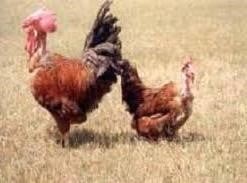
Fig. 1: CARI Debendra
(ii) CARI Nirbheek
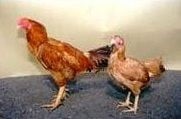
It is a cross of Indian native breed Aseel with CARI Red developed for free range as well as backyard poultry production (Fig. 2). These are very active birds, large in size, aggressive in nature with high stamina and majestic gait. They are able to save themselves from predators due to their fighting characters and activeness. They are also adopted to all climatic zones of the country for backyard production.
Fig. 2: CARI Nirbheek
(iii) CARI Upcari
CARI Upcari has been developed utilizing Indian native chicken with Frizzle plumage (Fig. 3). These are multicoloured birds with single comb and medium body size. Presence of Frizzle plumage helps in fast dissipation of heat due to which birds are better adopted specially in tropical climate in arid zones under backyard production.
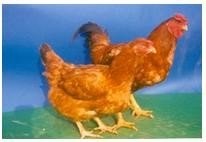
Fig. 3: CARI Upcari
( iv ) CARI Hitcari
This variety has been developed utilizing Indian native chicken with naked neck plumage, which are adapted to tropical climate especially for hot and humid coastal regions of the country. These multicoloured birds have single as well as pea comb and birds are larger in built (Fig. 4).
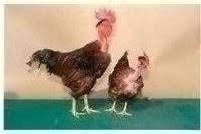
Fig. 4: CARI Hitcari
( v ) CARI Shyama
It is a cross of Kadaknath breed of Indian native chicken with CARI Red. Birds have plumage of various colours dominated by black (Fig. 5). The skin, beak, shank, toes and soles are dark gray in colour. The peculiarity of this bird is that most of the internal organs (muscles and tissues) show the characteristics black pigmentation. The black colour of muscles and tissues is due to deposition of melanin pigment, which causes increase in protein and decrease of fat and muscle fibre.
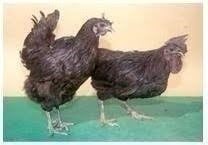
Fig. 5: CARI Shyama
( B ) Giriraja and Swarnadhara
Giriraja and Swarnadhara varieties were developed by Karnataka Veterinary, Animal and Fishery Sciences University, Bangalore. The hybrid coloured chicken variety named Giriraja (Fig. 6) was developed for backyard rearing by College of Veterinary Science, Bangalore. The birds have a high egg production potential along with better growth compared to local varieties and are suited for mixed and backyard farming. Giriraja female lays about 130-150 eggs a year. Each egg weighs about 52-55 g. The eggs have a good hatchability (80-85 per cent) and enable the farmers to raise their own stock. Day-old chick weighs about 42-45g. The eggshell is brown in colour and thicker than that of other commercial eggs and does not break easily. The eggs are priced at a premium rate of Rs. 3 to 4 in the local market. For backyard rearing, a flock of five hens and one cock can be ideally grown. No special care is required to grow them. They can be raised as free roaming birds and can be fed with locally available materials. Being good scavengers, they feed on a variety of insects and green foliage. They can also be fed on farm and kitchen waste. The birds are resistant to many diseases except Ranikhet disease.
Swarnadhara chickens have a high egg production potential along with better growth compared to other local varieties and are suited for mixed and backyard farming. The bird can be reared for its eggs and meat. It attains maturity from the 22-23rd week after hatching. Hens attain a body weight of about 3 kg and cocks about 4 kg. “Swarnadhara hens lay about 180-190 eggs in a year. When compared to Giriraja, this breed yields 15-20 eggs more in a year. Swarnadhara breed (Fig. 7) is smaller in size when compared to Giriraja with a lighter body weight, which makes them easier to escape attacks from predators such as jungle cats and foxes. Each egg weighs about 55-60 g with good hatchability (80-85 per cent) and enable the farmers to raise their own stock. A day-old chick weighs about 35-40 g. The eggshell is brown in colour and thicker than that of other commercial eggs and does not break easily. The eggs can be stored for 8-10 days at room temperature during summer and during winter for about 15 days. The eggs are priced between Rs.3 and 5 in the local market. The birds are only layers and not brooders. The eggs have to be hatched by local brooder hens. For backyard rearing, a flock of five hens and one cock can be ideally grown. The birds are sturdy and have a high longevity. No special care is required to grow them. They can be raised as free roaming birds and can be fed with locally available materials. Being good scavengers, they feed on a variety of insects and green foliage. They can also be fed on farm and kitchen wastes. The birds are resistant to major diseases except New Castle disease. A pair of Swarnadhara chicken fetches an income of about Rs.920 a year through the sale of its eggs and meat. One-day-old chicks and eggs of this breed are priced at Rs. 9 and Rs. 5, respectively.
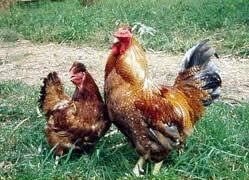
Fig 6. Giriraja
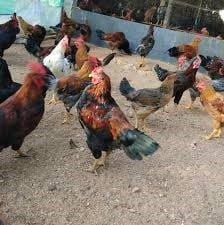
Fig 7. Swarnadhara
- Vanaraja
Vanaraja is a choice bird for backyard farming in rural and tribal areas developed by the Project Directorate on Poultry (PDP), Hyderabad (Andhra Pradesh). It is a multi-coloured dual purpose bird with attractive plumage (Fig. 8). The male parent is a coloured cornish strain and the female parent is a synthetic multi-coloured meat strain. The male parent has been developed for moderate juvenile body weight, long shanks and good immuno-competence. The female parent has been developed for high egg production, better egg size, high hatchability and immune competence. The plumage pattern and colour of Vanaraja bird is very attractive and closely resembles that of the desi fowl. It has better immune status against common poultry diseases and is adaptable to the backyard rearing. The general resistance to common poultry diseases and the ability to withstand adverse climatic conditions makes Vanaraja perform well in rural areas. Due to their relatively light weight and long shanks, these birds are capable to protect themselves from predators which are otherwise a major problem observed in birds reared in backyard. Further, the genetic potential of Desi hens can be improved by crossing them with Vanaraja males and the upgraded progeny of such a cross performs better than Desi bird for body weight and egg production. Vanaraja males attain moderate body weight at 8 weeks of age under regular feeding system and the pullets produce around 160-180 eggs in a laying cycle with minimum supplementation of locally available feed ingredients and other managemental inputs.
Day old Vanaraja chicks need brooding up to 4-6 weeks of age. They should be protected against Ranikhet disease through proper vaccination programme. During brooding period, they can be fed with layer starter diet. After brooding, these chicks need initial acclimatization to backyard environment before they are let free. Once they get adapted to the backyard farming conditions, they can perform better by scavenging for feed in the backyards. Additional feed need to be offered to the birds depending upon the extent of vegetation in the backyard and open area available for scavenging.
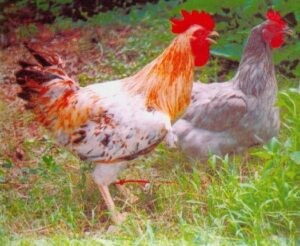
Fig 8. Vanaraja
Jharsim
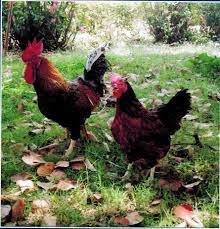
Jharsim is a dual purpose breed of poultry and suitable for tribal area of Jharkhand. The bird performs better on low level of nutrition with faster growth, optimum egg production and better adaptability to agro climatic conditions of Jharkhand. The breed has proven to be more resistant to diseases and can survive in natural habitat without much care. The birds weigh 1600- 1800 gm at maturity under backyard poultry farming system. These birds lay first egg at 6 months of age. The birds have the capacity to lay 165-170 eggs under backyard system.
Advantages of backyard poultry farming
- Provides additional income and employment to the rural households (women).
- It integrates well with other agricultural operations, so extra or in additional land is not required.
- Aids in enhancing the soil fertility in backyards (15 chickens produce 1- 1.2 kg of manure/ day).
- Produce of rural poultry farming fetches high price compared to those produce from intensive poultry farming.
- Waste material (insects, ants, fallen grains, green grass, kitchen waste, vegetable waste etc.) can be efficiently converted in to egg and chicken meat for human consumption.
- Alleviates protein malnutrition in vulnerable groups viz. expectant women, feeding mothers and children.
- Eggs and meat from birds reared under free range conditions have low cholesterol concentration compared to those produced under intensive poultry farming.
Constraints faced in Traditional Backyard poultry farming
- Lack of technical knowledge.
- Lack of suitable germplasm.
- Decrease in availability of natural resources of feed.
- Inadequate Veterinary support.
Popularization of Backyard Poultry Farming in Rural India
Backyard poultry farming plays an important role in providing income and protein to local rural people with minimal resource input. Although several organizations such as NGO’s, KVK’s, SAU’s has initiated to popularize the traditional Backyard poultry farming, it needs a lot more to be done to overcome its constraints so that backyard farming can be undertaken by each and every family of villages for their upliftment as far as possible.
- Vaccination schedule:
Follow the vaccination schedule as given below:
| Age of birds | Name of vaccine | Name of disease | Doses | Route of vaccination |
| Day old chicks | HVT MD Vaccine | Marek’s disease | 0.2 ml | s/c or i/m |
| 4-7 days | F-1/Lasota | Ranikhet disease | One drop | Eye or nostril |
| 14 to 18 days | Intermediate plus | Gumboro disease | – | Drinking water |
| 35 days | F-1/Lasota | Ranikhet disease | One drop | Eye and nostril |
| 6 to 7 weeks | Chicken embryo adopted | Fowl Pox | 0.5 ml | Wing stab method |
| 8 to 10 weeks | Strain killed vaccine | Ranikhet disease | 0.5 ml | s/c or i/m |
Economics of backyard poultry production (cost calculated for one RIR female)
- Cost of raising pullets upto the age of 20 weeks (egg laying starts)
- Cost of chick= 15/-
- Cost of vaccine and medicines= 30/-
- Cost of feed upto 20 weeks= Rs. 100/-
- Miscellaneous cost= 5/-
Total cost= Rs. 150/- (This cost includes all the expenditure incurred upto 20 weeks or first egg lay)
B. Recurring expenditure during the egg laying period)
- Feed cost= 720/- (100 gram feed/hen/day@ Rs. 20=2 X 30 X 12=720)
- Medicine cost= Rs. 30/-
- Miscellaneous cost= Rs. 20/- Total cost= 770/hen/annum
C. Income from backyard poultry birds
- Total egg produced= 180 eggs/hen/year
- Sale rate of egg=Rs. 10 /egg (desi egg)
- Total income from the sale of eggs= 1800/egg
D.Net income from backyard poultry production
- Expenditure: Rs 770/hen/annum
- Income: 1800/hen/annum
Dr. Rajesh Kr. Singh, BAHO, BAHRAGORA
Dr. Arati Veena Ekka
Director
Krishi Vigyan Kendra, East Singhbhum
Vill. – Darisai, (Kharia Colony), P.O. – Barakhurshi,
Dist.- East Singhbhum – 832 304 (Jharkhand) India
Edited, Compiled & Shared by- Team, LITD (Livestock Institute of Training & Development)
Image-Courtesy-Google
Reference-On Request.

BACKYARD POULTRY REARING AS A TOOL IN POVERTY REDUTION IN RURAL INDIA


